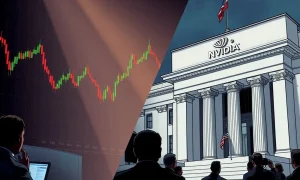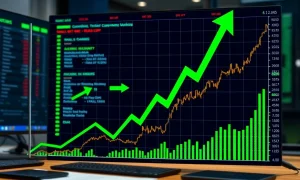Cava stock recently experienced a significant downturn. The fast-casual restaurant chain, known for its Mediterranean-inspired dishes, announced a trimmed sales outlook. This news sent its shares tumbling in the market. Investors and analysts are now closely watching the company’s next moves. The CEO’s comments shed light on challenging consumer behaviors. Therefore, understanding these developments is crucial for anyone interested in business and entrepreneurship.
Cava Stock Plummets: Understanding the Market Reaction
Cava Group Inc. (NYSE: CAVA) recently revised its financial projections. The company now anticipates lower sales growth for the current fiscal year. This adjustment immediately impacted Cava stock performance. Shares saw a sharp decline following the announcement. Investors reacted quickly to the revised outlook. Many expressed concerns about future profitability. The market often penalizes companies missing expectations. Cava’s stock had previously shown strong performance. Consequently, this revision surprised some observers.
The Revised Sales Outlook
Cava’s updated forecast indicates a more cautious approach. The company expects full-year revenue growth between 13.5% and 14.5%. This range is lower than previous estimates. Management cited several factors for the revision. These include slower customer traffic and reduced order sizes. Such trends reflect broader economic pressures. The fast-casual dining sector faces unique challenges. Furthermore, consumer confidence levels play a significant role in discretionary spending.
CEO’s ‘Fog’ Metaphor: Consumer Behavior Insights
Cava CEO Brett Schulman described current consumer behavior as navigating a ‘fog.’ This vivid metaphor highlights widespread economic uncertainty. Consumers are making more cautious spending decisions. High inflation continues to erode purchasing power. Interest rate hikes also impact household budgets. These factors directly affect discretionary spending. Dining out, a discretionary expense, often sees cuts first. Consequently, restaurants feel the pinch of reduced consumer spending.
Navigating Economic Headwinds
Schulman emphasized the difficulty in predicting consumer patterns. The economic landscape remains volatile. Many consumers feel uncertain about their financial future. They prioritize essential goods and services. Non-essential purchases, like restaurant meals, become less frequent. This shift presents a significant challenge for Cava. Other restaurant chains also report similar trends. Moreover, competition within the fast-casual segment intensifies during such periods.
Analyzing Cava’s Financial Health and Future Outlook
Before this revision, Cava had reported strong financial results. The company expanded its footprint steadily. New restaurant openings contributed to revenue growth. However, the recent outlook trim signals potential headwinds. Analysts are now re-evaluating their forecasts. They consider the impact of reduced consumer spending. Furthermore, they assess the company’s ability to adapt its operational strategies. The future of Cava stock hinges on these adaptations.
Analyst Reactions and Projections
Several financial institutions downgraded Cava stock ratings. Others revised their price targets downward. This reflects a more conservative view of Cava’s near-term prospects. Analysts monitor key metrics closely. These include average unit volumes and same-store sales growth. The company’s ability to adapt will be crucial. Future earnings reports will provide more clarity. Meanwhile, investors remain cautious.
Broader Implications for the Restaurant Industry
Cava’s experience is not isolated. Many restaurant businesses face similar pressures. The entire fast-casual segment feels the pinch. Rising food costs affect profit margins. Labor shortages also remain a concern. Consequently, restaurants must innovate to attract customers. Value propositions become increasingly important. Loyalty programs can help retain diners. Therefore, the industry as a whole is seeking resilient strategies.
Strategies for Resilience
Restaurants are exploring various strategies to mitigate these challenges. These efforts aim to maintain profitability. They also seek to sustain customer engagement.
- Menu Optimization: Focus on popular, high-margin items. This helps improve overall profitability.
- Operational Efficiency: Streamline processes to reduce waste. Furthermore, it helps control labor costs.
- Digital Engagement: Enhance online ordering and delivery options. This caters to changing consumer preferences.
- Targeted Marketing: Reach consumers with compelling offers. This encourages repeat visits.
Investor Perspectives on Cava Stock
Investors are now assessing the long-term potential of Cava stock. The recent tumble presents a new entry point for some. Others prefer to wait for more stability. Cava operates in a growing market segment. Its brand has strong appeal. Nevertheless, short-term volatility remains high. Investors should conduct thorough research. This includes evaluating the company’s fundamentals and market position.
Risks and Opportunities
Understanding both the risks and opportunities is vital for informed investment decisions concerning Cava stock.
Risks include:
- Persistent inflation reducing consumer spending.
- Increased competition in the fast-casual space.
- Execution risks in new market expansion.
Opportunities involve:
- Strong brand loyalty and product differentiation.
- Potential for market share gains during a downturn.
- Successful adaptation to changing consumer habits.
These factors will influence Cava’s trajectory.
Cava’s trimmed sales outlook and subsequent stock decline highlight current market challenges. The CEO’s ‘fog’ analogy accurately captures consumer uncertainty. While the short-term outlook appears challenging, Cava’s fundamental brand strength remains. The company must navigate economic headwinds effectively. Its ability to adapt will determine its long-term success. Investors will watch closely for signs of recovery and strategic adjustments. Therefore, continued monitoring of Cava’s performance is advisable.
Frequently Asked Questions (FAQs)
Q1: Why did Cava stock tumble recently?
A1: Cava stock tumbled after the company trimmed its full-year sales outlook. The revised forecast indicated slower anticipated revenue growth, leading to investor concerns about future profitability.
Q2: What does Cava’s CEO mean by consumers navigating a ‘fog’?
A2: Cava’s CEO, Brett Schulman, used the ‘fog’ metaphor to describe the current economic uncertainty affecting consumer behavior. This includes cautious spending due to high inflation, rising interest rates, and general economic apprehension.
Q3: How does Cava’s situation impact the broader restaurant industry?
A3: Cava’s situation reflects broader challenges within the restaurant industry, especially the fast-casual segment. Many chains are experiencing reduced discretionary spending, rising operational costs, and a need for innovative strategies to attract and retain customers.
Q4: Is Cava stock still considered a good investment after this news?
A4: Investment decisions depend on individual financial goals and risk tolerance. While Cava stock recently declined, its long-term potential depends on the company’s ability to adapt to market conditions and consumer behavior. Investors should consult financial advisors and conduct their own thorough research before making any decisions.
Q5: What strategies is Cava likely to employ to counter these challenges?
A5: Cava, like other restaurants facing similar headwinds, is likely focusing on several key strategies. These include menu optimization for profitability, enhancing operational efficiencies, strengthening digital engagement for online orders, and implementing targeted marketing campaigns to retain and attract customers.
Q6: What should investors look for in Cava’s future reports?
A6: Investors should closely monitor key metrics such as same-store sales growth, average unit volumes, new restaurant opening rates, and profit margins. These indicators will reveal how effectively Cava is navigating the challenging economic environment and adapting its business model.








